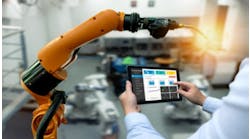We frequently talk about predictive maintenance, but consider the concept of predictive solutions—
Zebra Technologies' Alex Cooper
assigning the right resource to the right task at the right time with the use of mobile devices. That’s how Zebra technologies defines predictive solutions in their recent study, which predicts that this practice will double by 2025 in fields like telecommunications, manufacturing, construction, mining, and agriculture.
Additionally, the study found that field service providers cited mobility investments as a top priority over the next five years, in order to enable strategic predictive solutions in daily operations.
We wanted to learn more, so we connected with Alex Cooper, Zebra's director of government strategy and market development. Take a look…
Smart Industry: Why will field service adoption of predictive methods increase so dramatically?
Alex: Rising customer expectations, skilled-labor shortages, and the need for continued differentiation in the market are driving organizations with large field service operations to become more efficient in their workflows. Utilizing predictive solutions allows for better demand planning, ensuring the right assets are deployed at the right time.
Smart Industry: What tools enable this?
Alex: Predictive-analytics software, and the continued utilization of AI and intelligent modeling can aggregate millions (potentially billions) of data points. These data points can come from IoT-enabled sensors, real-time and historical weather information, live traffic data, real-time information from rugged mobile devices in the hands of remote field technicians and more. All of this information allows work orders, navigation routes, inventory ordering, rescheduling of maintenance activities and more to be reprioritized at any time, allowing resources to be deployed based on the highest need. Accessing this information securely, safely, and quickly is essential, and it requires dedicated enterprise-class mobile devices that are field-tested to work in adverse conditions and allow field technicians to perform their duties.
Smart Industry: What kind of predictive efforts are we talking about?
Alex: If there is a data point, it can be assessed, tracked and utilized to make better decisions. For example, field technicians can more easily know when an equipment repair is needed if there is a pre-set risk threshold based on reported performance, strain, repair history, manufacturer recalls, etc. If we know that an automatic circuit recloser is located in a storm-prone area with a lot of lightning activity and hasn’t been serviced in two years, we can interrogate it using SCADA. If we don’t get a response we like, it can be added to the work-order backlog with a high-priority flag and be scheduled for a visual inspection and maintenance work. Depending on the level of sophistication, this could be 100% automated, up until the truck is scheduled to roll to the site. It likely isn’t fully automated yet, but the combination of data points gives us great information to make more informed decisions.
Smart Industry: Does this trend mirror other industries?
Alex: Absolutely. If you look at a smart city initiative where sensors remotely monitor traffic conditions, video cameras, light poles, and even buildings, you can draw a parallel to energy and utilities. Just as in the electric grid example above, a city can dispatch resources—whether public safety, public works or public transit—in real time based on remote-sensor input. This input can also predict when key infrastructure is likely to degrade or fail, when and where a traffic bottleneck might occur, or even when large groups gather unexpectedly using video analytics. The retail industry is also advancing their use of predictive analytics to mitigate inventory issues, loss prevention across stores, and vendor compliance.
Smart Industry: What's the reception from the personnel implementing these changes?
Alex: Most field service workers that we’ve spoken to in the energy and utilities sector are embracing these new technologies. This may be because the field service worker spends significantly less time navigating to locations and filling out physical paperwork once digital mobile technology is in place. Maximizing the amount of time a field tech can complete actual work without being burdened by administrative tasks while on-the-go increases worker productivity and satisfaction overall.
Smart Industry: What most surprised you with the findings in the study?
Alex: We were a bit surprised that respondents reported “increased worker satisfaction” as one of the top three benefits they expect to realize once mobility solutions are deployed. This reinforces the positive reaction from field service workers, and also suggests that digitizing field service operations may have an impact on energy and utilities companies’ workforce-retention efforts. By reducing or automating the non-essential work, field service technicians can complete more hands-on work which benefits everyone.




